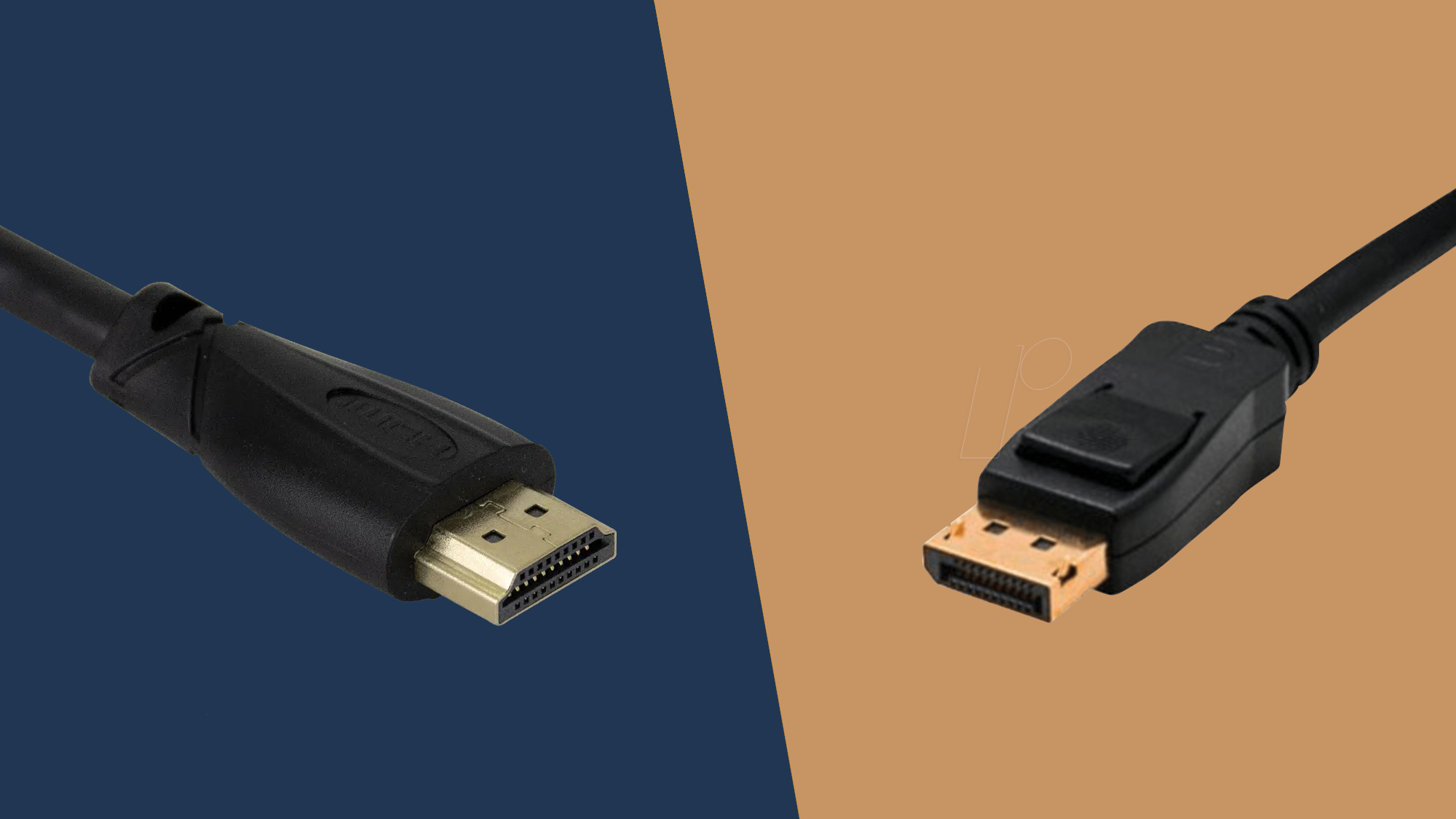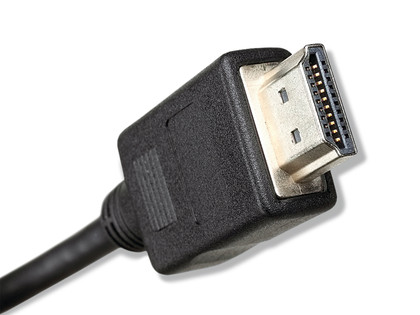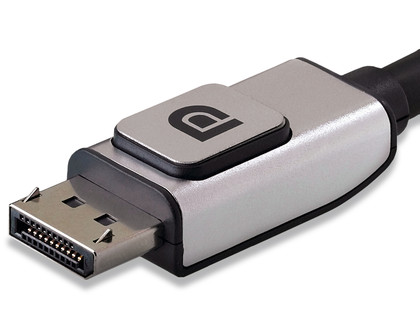HDMI vs DisplayPort: which is best?

Figuring out whether to use HDMI vs DisplayPort connections isn’t always easy, especially if you’re unaware of the difference between the two. Most GPUs come equipped with both ports nowadays, so you might not have given much thought to which is better. However, there are ways for you to utilize both ports for peak performance, and we’ll explain why.
What’s interesting about comparing DisplayPort and HDMI is it isn’t a traditional “competition,” as they’re both completely digital standards with a lot of overlapping traits. They have almost interchangeable specifications and capabilities, not to mention audio and video quality. No matter which one you use, you’ll end up with a fully digital connection that permits 3D images and copy protection.
That’s not to say, however, that some situations don’t call for HDMI over DisplayPort, or vice versa. While it’s unsurprising that powerful AMD Radeon cards like the RX 6800 and RX 6700 XT come equipped with both connections, it’s impressive that some budget options like the Nvidia GeForce GTX 1660 Super and RX 5500 XT also have DisplayPort and HDMI options. However, there are other budget options that will only come with one or the other, so it’s best to know which will work best for your needs.
It seems HDMI and DisplayPort are here for the long haul, so you don’t have to worry about future-proofing your rig when deciding which is best. Instead, you just have to focus on the ways they differ and which ones are best suited to your tech setup. DisplayPort and HDMI get the same job done in different ways, so you’ll want to familiarize yourself with how they accomplish them. That said, you won’t have to worry about a loss in quality if you pick one over the other.
What you will have to grapple with, however, is how much you’re willing to spend on these connections. It’s true some GPUs have both already available for use, but it’s been shown that DisplayPort tends to be more expensive than HDMI. You can invest in DisplayPort if you don’t mind the extra cost, but if you’re on a budget an HDMI connection works just as well. Plus the newest HDMI 2.1 has already shown a promising impact on shows, movies, displays, and most importantly gaming.
We’re here to compare HDMI vs DisplayPort, discussing their individual strengths, disadvantages, and why card manufacturers ultimately decided to put both onboard their GPUs. While both standards are great, it’s crucial to know which will serve you best.
HDMI explained
The High Definition Multimedia Interface first appeared in 2003 and was designed as a digital replacement for the multitude of analogue formats used in consumer AV standards (RF, SCART, Composite, S-VHS, RGB and so forth), in a compact single cable.
Sign up for breaking news, reviews, opinion, top tech deals, and more.
HDMI hails from the world of TVs, DVD players and consumer electronics. It takes as its starting point S-VHS and composite signals. DisplayPort hails from the computer chaps and uses a more sophisticated and flexible data transmission method.
It can carry any uncompressed TV signal with 48-bit colour and up to eight channels of audio as well as control connections for the rare instances where one bit of kit can control another.
The standard was put together by a consortium of big names, including Panasonic, Sony, Philips and Toshiba. The specification has now reached version 2.1.
The big gain in the later versions is the maximum clock speed, which governs bandwidth. The original specification called for a maximum of 165MHz, which is just enough to handle 1080p.
Version 2.1, the current version, delivers improved bandwidth of 48Gbps and can carry resolutions of up to 10K at 120fps, enough for a very beefy modern home cinema setup.
It comes in single-link or double-link types (the 19-pin Type A and 29-pin Type B respectively), Type B equates to dual-link DVI, although we haven't seen one yet.
HDMI 2.1 launched in November 2017 and adds scene-by-scene HDR, less image lag for games, 8K resolutions and spatial audio.
An HDMI 2.1 cable with 48Gbps will be necessary to experience the technology's capabilities, and you'll need a compatible HDMI 2.1 port on any connecting hardware as well.
There's no standard set for the maximum cable length, it's essentially down to the cable company to get it working properly. The signal drops off, so the longer the cable, the thicker the wire and therefore the better the quality required.

HDMI benefits
HDMI includes CEC: Consumer Electronics Control. The idea is that one bit of AV kit can pass across instructions to another, such as turn on, change channel, and so forth. Nice when it works, which isn't as often as you might like. No big loss on a PC.
HDMI has native support for BT.2020 with 10, 12, and 16 bits per color component, enhanced eARC for object-based audio formats such as Dolby Atmos and DTS:X, and scene-by-scene and frame-by-frame dynamic HDR.
If you've a new television then it will have an HDMI port, making connecting a PC really easy, at last. This is the big bonus, games coming at you with real screen acreage.
HDMI kit is currently very affordable, especially for compatible monitors.
DisplayPort explained
Three years after HDMI first made its way into homes, DisplayPort was unleashed into the world. The standard was hammered out by VESA and was designed principally to go betwixt graphics card and monitor.
Importantly, it also happens to be royalty-free (as opposed to the four cent per device royalty charged to HDMI devices). DisplayPort was adopted after the United Display Interface (UDI) standard, principally developed by Intel as a DVI replacement, was canned.
Unlike the aforementioned HDMI, DisplayPort is a completely novel standard. This means that it isn't possible to produce an easy connection converter in the same way it was for HDMI.
Having said that, there is a special DP++ port, which offers multi-mode connections (including single-link HDMI and DVI signals) and can be used with a suitable converter cable. It is all a bit of a fudge, though, and requires a non-standard physical port.
DisplayPort uses a packet-based transmission system, enabling flexible use of bandwidths. It comes in one-, two- and four-link versions with increasing data capacities.
The original version could transfer a maximum of 8.64GB/s, while the 1.4 specification (which has been around since March 2016) has a maximum total bandwidth of 32.4Gbps and a maximum total data rate of 25.92 Gbps.
DisplayPort specifies a maximum cable length of three metres for copper and fifteen meters or more for fibre optic. If you are serious about putting space between box and monitor, then this is clearly the display interface of choice.
DisplayPort was designed from the outset with direct graphics card/monitor connection in mind, including the internal one. It can run a monitor directly from the DisplayPort signal, with no Low Voltage Differential Signalling (LVDS) circuitry required on the panel.

DisplayPort benefits
DisplayPort is royalty-free. HDMI costs currently only four cents a pop, mind. DisplayPort has fewer rules over implementation too and is not so highly regulated, so manufacturers can have more fun with it.
Technically more accomplished, flexible and capable of carrying much more than just video and audio. It also supports multiple monitors on one cable, so you can daisy-chain two or more together.
DisplayPort also offers three-metre copper cable at full resolution, its also been designed for fibre optics too, enabling much longer cables. HDMI has no maximum cable length and the signal can degrade.
It can run Direct Drive Monitors. This is of most significance internally in laptops, but we should see external DD monitors, which can be thinner, and one would hope, cheaper.
There's a bi-directional auxiliary channel, which can be used for input from a microphone or USB device.